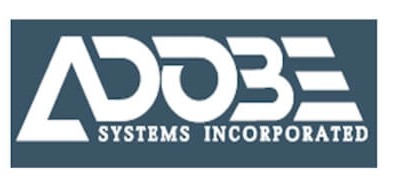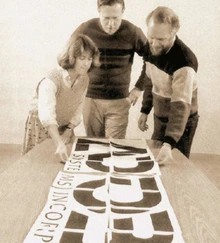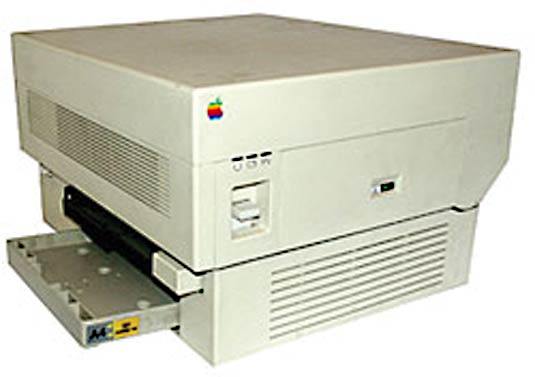| John Warnock - Father of PostScript |
Page 2 of 3
AdobeLike most of the good ideas developed at PARC, Xerox really didn't have a clue what to do with it and so Geschke and Warnock left to form a company to do the job. The company, Adobe Systems was founded in 1982 and was named after the creek that ran past Warnock's garden in Los Altos (California). The company's first logo was designed by his wife, Marva Warnock, herself a graphic designer and illustrator. Its first letter, A, looks like an opened triangle while the last letter, E, comprises three horizontal stripes. Source: Adobe.fandom.com Marva Warnock (left) presents tiled printouts of the Adobe Systems logo design to co-founders Charles Geschke (center) and John Warnock (right) in 1982. At first Warnock and Geschke seemed to have as much idea about how to market a graphics language as Xerox. They planned to build a really powerful printer and have users bring their work to service bureaus. They quickly discovered that backers for a service company were hard to find. To make the product more like a hardware product, they then switched to building workstations plus laser printers but gave that up when they discovered that other people had the same idea. Finally, they hit on the right one. They would market the PostScript language, fonts and laser printer controllers. In other words, become an OEM (Other Equipment Manufacturer), a supplier of software. It is said that PostScript took 20 man-years of programmer time to perfect. It was certainly the most complex piece of software to be offered for use on the growing number of personal computers. To run fast it needed a powerful computer all of its own and for a while the cost of the hardware was a problem. This is where Apple and Steve Jobs enter the picture. Steve had borrowed many of the ideas from Xerox Parc and many of the personnel to create the Mac. But the Mac wasn't the great seller that it should have been. The 128KByte Mac of the time plus a dot-matrix printer just wasn't a viable business system. In 1984 the HP LaserJet was just beginning to make an impact in the PC world, but it produced output that looked like a typewriter. It really was just a dot matrix printer brain inside a laser printer body.
Steve Jobs made the bold decision to make a laser printer for the Mac with output that looked typeset. To do it he wisely bought 15% of Adobe at a cost of $2.5 million. The Apple LaserWriter, including the controller card, was designed and built by Apple. Adobe supplied the software and the fonts. The result was the desktop publishing revolution and the rise of the Mac. You could say that it was the LaserWriter that was the success and the Mac just happened to be dragged along to fame and fortune by the printer cable.
With the success of the LaserWriter, PostScript established itself as THE page description language. It was, and is, used not only on laser printers but also by high resolution image setters. This is only possible because the language is far more general in design than the problem of printing to a laser printer ever demanded. This generality of design seems to be a tenet of John Warnock's philosophy. Another seems to be theoretical purity. PostScript was only just practical, in the sense that it still needed a very powerful processor to run it. When Apple asked if it was possible for Adobe to make one or two tweaks to speed it up the answer was "no". The PostScript language had to remain pure and modifications and additions to the language-specific hardware were an anathema to Adobe, and presumably to John Warnock in particular. This is the weakness that comes with the strengths of being a mathematician at heart. Adobe has also been poor at marketing and understanding their users over the years. You get the impression that they don't know that users exist. The crunch came in 1988 when Bill Gates asked Warnock for PostScript code and fonts to be used in the next version of Windows. He didn't want to pay for it, however, arguing that the publicity would do Adobe good. John Warnock said "no" and as a result Microsoft and Apple got together to produce their own font technology. Apple actually informed Adobe that it would be phasing out PostScript and sold the shares that they still had in Adobe. As a reaction Adobe announced ATM for the Mac, which allowed Adobe fonts to be displayed on Mac screens long before Microsoft and Apple could do the same thing. Well it would have if the product existed, but they did at least put one programmer on the job straight away! ATM was Adobe' second attempt at creating font technology for the screen - the first being Display PostScript which they unaccountably abandoned before it was completed. The alliance between Microsoft and Apple never did bear any fruit, mainly because Microsoft found font technology harder than anticipated. Only later, after a split with Apple, did Microsoft offer an alternative to Adobe fonts by way of TrueType in Windows 3.1. With TrueType and ATM for Windows running in parallel the Windows-using community had a difficult choice between two similar font technologies. Today Adobe is better known for its graphics editing technology - to PhotoShop has become a generic verb - even if there are other graphics editing programs. It was also known for the Flash web technology which Steve Jobs took such a dislike to that eventually Flash was killed off - an early example of cancel culture. Nowadays web technology and especially printers tend to be treated as black boxes that just print what appears on the screen. However, Postscript is still important as it is the language used in Adobe's PDF - Portable Document Format - technology and it is still used in many high quality printers. |
||||
| Last Updated ( Monday, 21 August 2023 ) |



